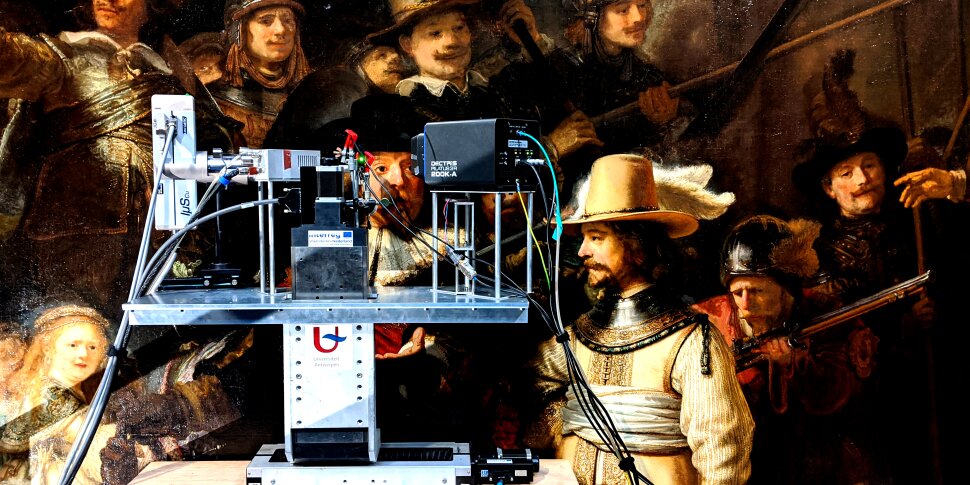Night Watch
Scientists analyse world-famous painting in great detail with unique scanner

From 15 to 30 January 2019, members of the research group AXES, part of the Nanolab Centre of Excellence of the University of Antwerp, Belgium, are active in the Gallery of Honour of the Rijksmuseum (RM, Amsterdam), scanning (parts of) Rembrandt's masterpiece ''The Nightwatch" (1642) using a device called the Macroscopic X-ray Power Diffraction Scanner (MA-XRPD). This instrument, in an innovative and completely non-invasive manner, can record images of the distribution of materials that are present at the very surface of the paint.
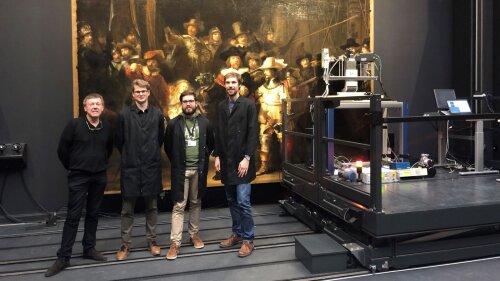
From left to right: Prof. Koen Janssens, Arthur Gestels, Steven De Meyer and Dr. Frederik Vanmeert (all UAntwerp) in front of the Nightwatch and next to the elevator stage on which the MA-XRPD scanner is mounted.
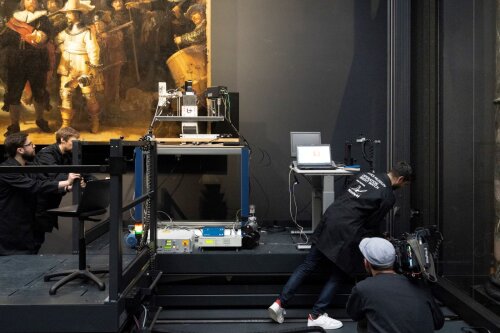
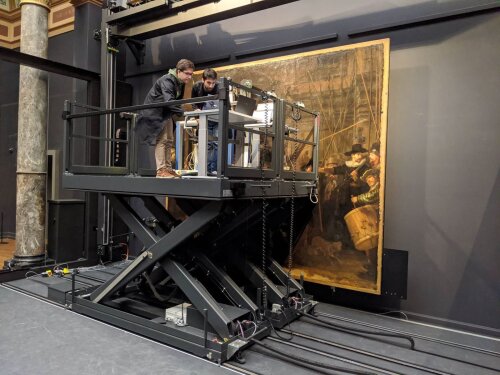
(left) Steven de Meyer, Dr. Frederik Vanmeert (UAntwerp) and Dr. Victor Gonzalez (RM) pushing the elevator stage towards the right. (right) Steven De Meyer (UAntwerp) and Dr. Victor Gonzalez (RM) analyzing an upper area of the Nightwatch with MA-XRPD.
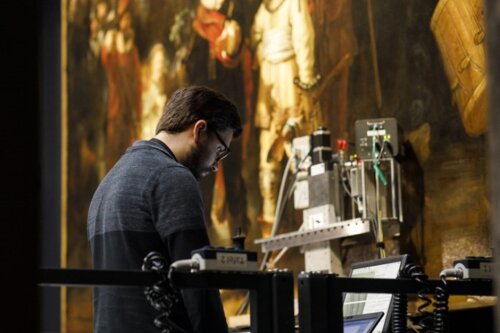
Steven de Meyer (UAntwerp), contemplating the MA-XRPD data being collected from the lower right area of the Nightwatch.
For the measurements, the MA-XRPD scanner is mounted on two large elevator stages that were placed in fron t of the painting in the ''glass house'', a transparent enclosure that was built around the Nightwatch.
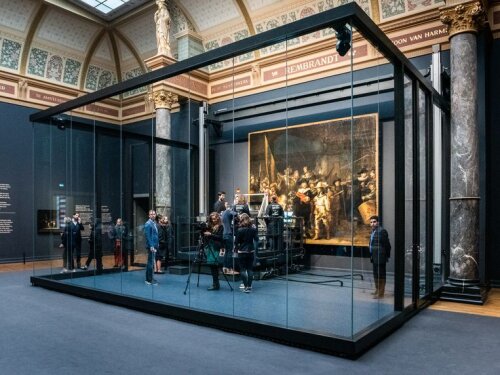
General background
Watch Sotheby's 3 min video on the Anatomy of the Nightwatch by clicking on the image below.
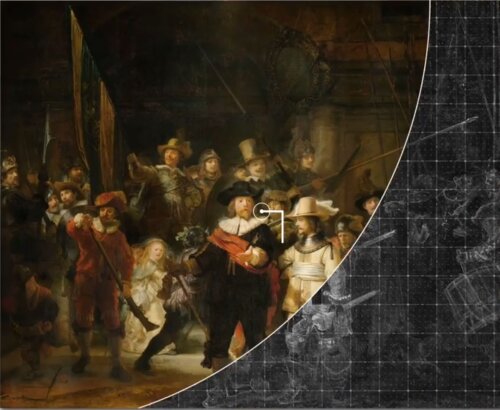
Aims
The general aim of the MA-XRPD investigation is to obtain more information on various types of spontaneous chemical transformations that have taken place during the last 370 years in the painting, affecting in various ways the properties of materials that constitute it.
In collaboration with the colleagues from the Rijksmuseum, a number of specific research questions were formulated. These fall essentially into two categories: (a) which original materials did Rembrandt use (or not use) ? and (b) which materials show degradation invisible to the naked eye and where are these located in the painting ? To answer these questions, measurements are focussed on a number of key areas of the Nichtwatch, such as for example the face and red sash of Captain Frans Banninck Cocq (the main figure in the painting), the yellow uniform of Luitenant Willem van Ruytenburgh and the very degraded area of the dog. Also the part of the painting that in the past was sprayed with sulfuric acid (over the musketeer in the red costume, Jan Van der Heede) will be investigated. (Click on the figure below to beter see the areas of interest.)
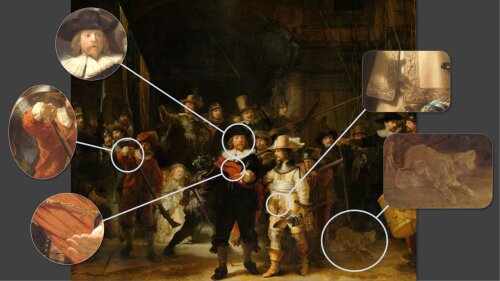
To inform the general public that is visiting the museum, the purpose of the MA-XRPD measurements is explained in a few sentences, painted on the Rijksmuseum walls adjacent to the Nightwatch.

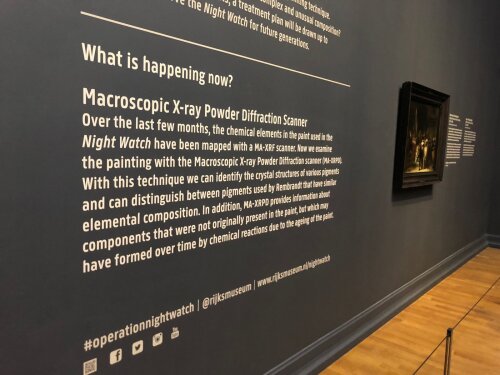
MA-XRPD team
Members of the AXES research group operating the MA-XRPD scanner are Steven De Meyer and Dr. Frederik Vanmeert in collaboration with several scientists of the Rijksmuseum such as Nouchka De Keyser, Dr. Victor Gonzalez, Dr. Francesca Gabrieli, Dr. Anna Krekeler, Dr. Annelies Van Loon, Prof. Dr. Katrien Keune (Head of Science, RM and University of Amsterdam) and Dr. Robert Van Langh (Head of Conservation & Science, RM). Also several members of the paintings conservation department of the Rijksmuseum such as Petria Noble and Susan Smelt are involved in this part of the operation. Dr. Van Langh studied Art Restoration and Conservation at the University of Antwerp.
X-ray powder diffraction is a suitable method to investigate paint phenomena because it is able to identify chemical compounds in a highly specific manner. The method also has the advantage that it is non-destructive and that it provides results in the form of images: distribution maps of crystalline chemical compounds.
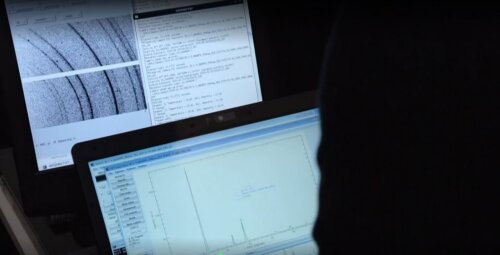
X-ray diffraction patterns and spectra being collected from the Nightwatch.
A paper on the use of MA-XRPD for investigation of another famous Dutch painting, The Girl with the Pearl Earring by Johannes Vermeer (Mauritshuis Museum, The Hague) can be found here. Another paper on unusual lead compounds found in the Nightwatch is can be found here.
Operation Nightwatch
More general information on the scientific studies undertaken by the Rijksmuseum as a preparation of the planned restoration of the Nightwatch can be found here.
Several Instagram movies on Operation Nightwatch are available. In one of these Dr. Victor Gonzalez explains about his research on the chemical transformations related to the pigment lead white.
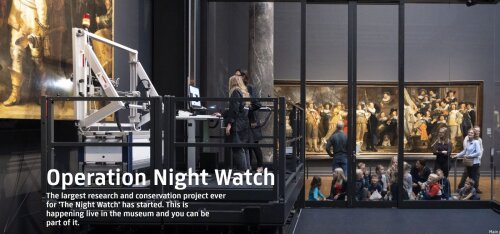
Before MA-XRPD: MA-XRF scanning
One of the methods employed by the Rijksmuseum to examine the painting below the surface, is Macroscopic X-ray fluorescence analysis. In the pictures above and below, the instrument positioned before the Nightwatch is the Bruker M6 "Jet Stream" MA-XRF scanner. This method was initiated ca 10 years ago in the AXES group, in close collaboration with Prof. Jorik Dik of TUDelft, the Netherlands. He is the lead author on the first scientific publication on MA-XRF, dating back to 2008. The Bruker M6 MA-XRF instrument, described in a paper from 2013, became available during/was inspired by the PhD work of Dr. Matthias Alfeld at UAntwerp/AXES, now assistant professor at TUDelft. Many major museums (in Paris, London, Washington DC, Los Angeles, ...) now employ MA-XRF scanners of their own.
In the photo below, the MA-XRF scanner is being operated by Petria Noble, Head of the Paintings Conservation Workshop (RM) and Dr. Annelies Van Loon (Science Department, RM) to scan the upper half of the Nightwatch, requiring the large elevator stage to be in its highest position.
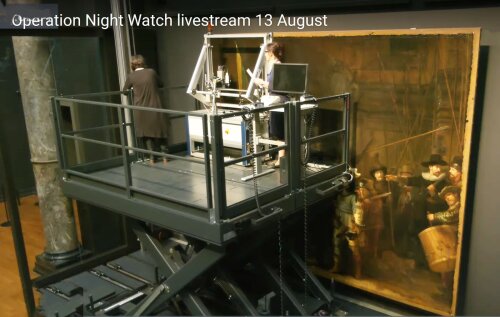
Dr. Annelies Van Loon explains how the instrument works in this movie. In another Instagram movie, Petria Noble discusses some of the discoveries recently done on the Nighwatch by means of MA-XRF.
